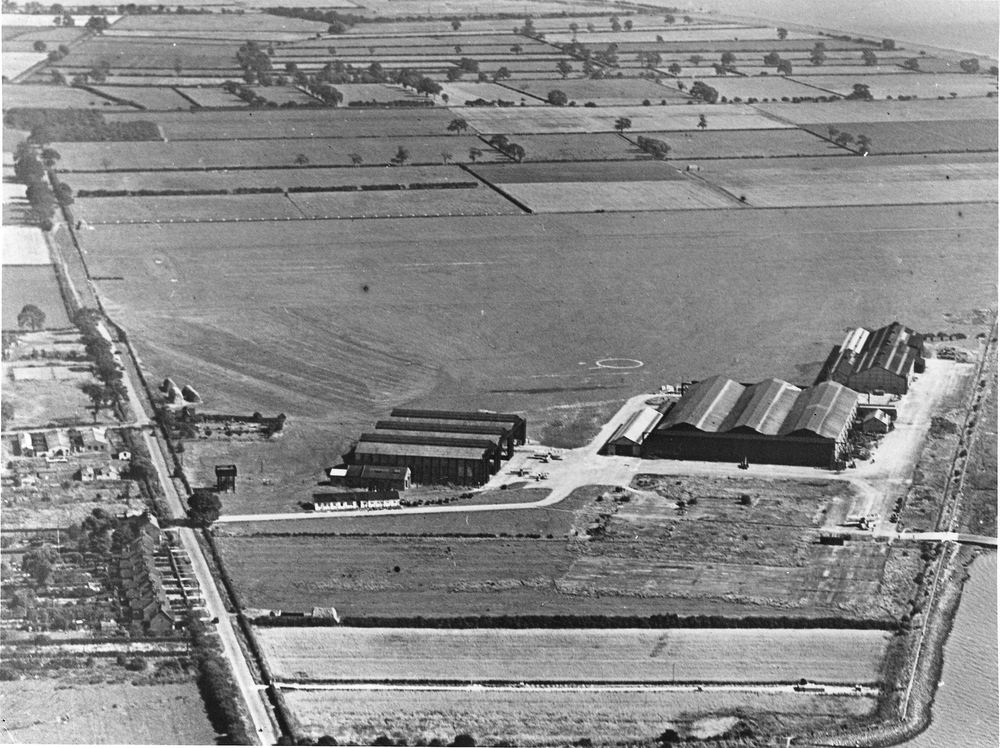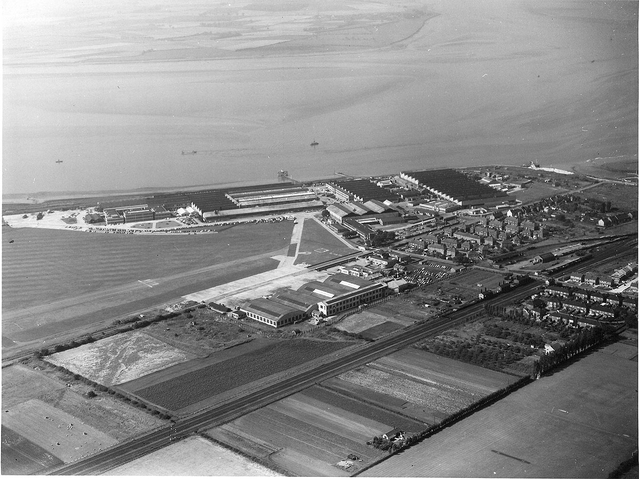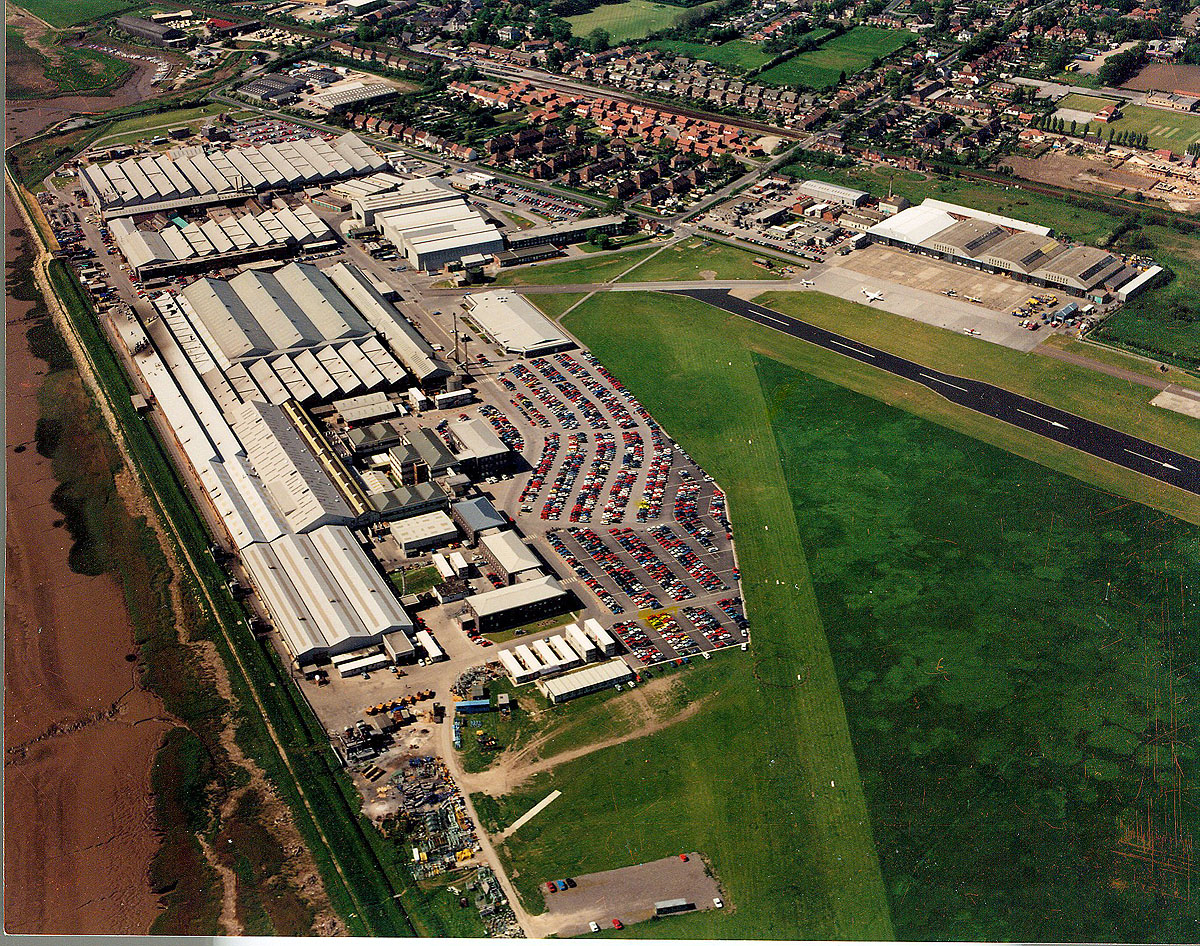
Founded 1916 by aviation pioneer Robert Blackburn. One of the world's oldest surviving sites of aircraft manufacture.
Humber Enterprise Park
Brough
East Yorkshire
This Red Wheel heritage plaque celebrates one of this country’s aviation pioneers, Robert Blackburn and his Brough factory where so many great aeroplanes were developed and built.
The Trust were invited to consider the site for a Red Wheel by the site’s present owners, Humber Enterprise Park supported by the successors to Blackburn Aircraft, BAE Systems.
The site is still occupied by BAE Systems who continue to manufacture at least 40% of the Hawk aircraft there along with other high-tech research and development. The new F-35 Lightening airframe has had its airframe tested in Brough’s rig which previously played host to the Eurofighter Typhoon.
With such an illustrious history, the Trust were delighted to agree to the Red Wheel which now graces the Gate House at the site.
And for the unveiling we were honoured to have Robert Blackburn’s daughter, Janie Rayne and her son Damien Rayne, himself a pilot with rotary and fixed wing types under his belt.
Trust Chairman Stuart Wilkinson introduced guests to the Red Wheel scheme whilst Trustee Jerry Swift outlined the basis for awarding the Red Wheel. Janie said how delighted show was to see her father honoured.
She described going for an early flight with a father on the famous Beverley military heavy-lift aircraft. She remembered how it shook on take-off and was so noisy in flight.
A reception in the nearby former fire station included many photos of the site and its products over the years and a full-size replica of an early Blackburn monoplane built by some of the site’s heritage group members.
The site has been responsible for a number of famous military aircraft including The Buccaneer, Harrier, Hawk as well as introducing the Phantom to UK service. The site has also contributed to Airbus projects and other Hawker Siddeley civilian aircraft such as the Trident.
The Trust has reproduced some fascinating material on our website that describes much of the history of the site, starting in 1916 but is worth recalling how Blackburn identified the site.
A major catalyst to the expansion of the Blackburn business was the award of a government contract to manufacture 12 BE2's under licence, news of which was received by telegram from Winston Churchill, then first Lord of the Admiralty, on the very day of Blackburn's wedding. The expansion of the business which had started in Leeds, concentrated the mind and efforts of Blackburn on the future design and function of the aeroplanes he would produce, and the company began its long association with seaplanes. The first Blackburn bi-plane was designed in 1915 as a seaplane, the Blackburn Type L aircraft, and thoughts turned to the desirability of an East Yorkshire coastal base.
The actual finding of what became the Brough site happened quite by chance. On the night of the August 9, having seen the nightshift on at Leeds, Robert and his wife Jessica and two young nieces set off by car to stay the night in a hotel in Hull, so as to be able to witness the trial flight one of the seaplanes on the early morning tide from Scarborough to the naval station at Killingholme.
The same evening Captain Odo Loewe, commanding the German naval Zeppelin L9, navigated the North Sea with an intention to bomb Kingston-upon-Hull. This was planned as a follow up to the earlier raid on the night of June 6-7 that had caused great damage and terror in the city.
Thankfully for Hull, a worsening fog developed and, unable to navigate the correct course and direction, the Zeppelin turned east on finding the Humber and eventually bombed Goole and Hotham before returning back to the safety of the North Sea.
As the Zeppelin was groping around close to South Cave on its inward journey the Blackburn party had been stopped on their journey to Hull by "Specials" (members of the special police constabulary) and told that on account of the airship’s activity in the vicinity they could go no further.
Abandoning their original plans, Robert managed to persuade the constables to take them to a nearby village to find somewhere to stay overnight. With the Specials standing on the running board on each side of the car, they motored towards South Cave and Brough.
As the Zeppelin had passed overhead looking for landmarks, Blackburn and his family took refuge in a roadside ditch.
Resuming their journey once the airship had left, Robert, Jessica and the children were escorted to the Station Hotel at Brough, where they stayed overnight.
Early the next morning while Jessica was dressing the children, Robert went for a long walk along the banks of the Humber. Three hours later he returned in an excitable state, kicking his heels in the air, telling Jessica he had found just the land for a new Blackburn aerodrome.
BAE Systems illustrated history of the Blackburn Aircraft Factory site at Brough
Whilst the aircraft manufacturing side of the factory on the banks of the Humber may have reduced, the BAE Systems facility at Brough in East Yorkshire still maintains a vital role in the company’s military aircraft business as the engineering centre for the Hawk trainer, many hundreds of which remain in service with air forces throughout the world and as the UK centre for Military Aircraft Structural Testing.
Having set up his business in 1910, aviation pioneer Robert Blackburn incorporated the Blackburn Aeroplane and Motor Company in 1914 and established a new factory at Brough in the East Ridings of Yorkshire in 1916.
The First World War was raging in Europe and Blackburn was rapidly producing seaplanes for the allied forces and the Humber River would prove to be a convenient test facility. Whilst the Blackburn family relate that Robert identified the site himself, some however, have laid claims that it was chosen by Mark Swann, an aide to Blackburn, due to its proximity to 2 pubs!
During the mid-war years, Brough concentrated on the continued production of torpedo bombers, seaplanes and patrol aircraft, creating many designs for consideration and use by the Fleet Air Arm. Aircraft such as the Blackburn Dart, Ripon, Baffin, Shark and Skua were being produced in their hundreds as were a series of mighty three-engine flying boats culminating in the Blackburn Perth armed with a 37mm anti-shipping cannon.
Civil aircraft were not ignored with the introduction of the two-seater side-by-side Bluebird club aircraft which subsequently developed into the B2 trainer. It was a Bluebird that won the prestigious King’s Cup Air Race in 1931 and another Bluebird IV was used by Mrs Victor Bruce in her famous round the world flight in 1930- 1931.
Throughout most of the inter-war years Brough was a centre of Reserve Flying Training for the Royal Air Force, becoming No.4 Elementary and Reserve Flying Training School in 1935 and then as No.4 EFTS, providing wartime training for a range of pupils.
In 1934, Blackburn acquired Cirrus Hermes Engineering and moved the company into a new building on the Brough Site where it was subsequently renamed it as Blackburn Engines Ltd. The Blackburn Engine Company remained in business until rationalisation of the aircraft industry in the 1960s where the name was subsumed into Hawker Siddeley Aviation.
With the outbreak of World War II, Brough intensified its production of the Botha light bomber / trainer and latterly, the Fairey Barracuda naval torpedo bomber.
New Blackburn sister factories were built, one at Dumbarton for production of the Shorts Sunderland flying boat and the Brough designed Blackburn Botha with another at Sherburn in Elmet building the Fairey Swordfish. During the same period Brough was also involved in considerable amounts of work adapting nearly 4000 American aircraft and repairing damaged aircraft.
An amalgamation with General Aircraft Limited (GAL) in 1949 resulted in the arrival of the GAL Freighter prototype at Brough, an aircraft later modified to become the Blackburn Beverley with production reaching its peak in 1953. Between 1949 and 1957 the Runway and airfield Perimeter Road became a race track at occasional weekends and can lay claim to be the venue where Sir Stirling Moss recorded his first ever race victory.
Brough received a number of VIP visitors during these busy periods including Earl Mountbatten who opened the new high speed wind tunnel during the late 1950s.
With the exception of a single YB2/HP88 research aircraft, Brough and Blackburn’s first venture into the jet age was with the introduction of the Buccaneer, a carrier-borne attack aircraft. Designed by Barry P Laight in the 1950’s, the Buccaneer remained in service with the RAF until 1994 and proved to be one of their most successful products having entered service with the Royal Navy in 1962.
With the rationalisation of the aircraft industry in 1963, Blackburn Brough became part of Hawker Siddeley Aviation and concentrated on the Buccaneer although it became increasingly engaged in component manufacture and testing work for other parts of the organisation.
A few years later, Brough was selected as the ‘Sister Design Organisation’ for the 170 Rolls-Royce powered, McDonnell F4 Phantom aircraft which entered service in 1969 with the Royal Air Force and Royal Navy. During its UK service career, fifty Phantom squadrons were supported by the Brough engineering teams and there were 296 returns to Brough for modifications and repair.
The combination of responsibility for Buccaneer and Phantom meant that from 1972 until 1978 the Brough factory was responsible for both of the Fleet Air Arm’s formidable front line aircraft. Other projects continued alongside and these included work on the Trident airliner fuselage, structural component machining for what is now Airbus as well as BAe 146 airliner parts.
Extensive work was carried out on the Harrier Jump Jet and the Hawk trainer projects with the latter subsequently being produced as a complete aircraft.
During the 1970s, Hawker Siddeley was amalgamated further with British Aircraft Corporation to become British Aerospace and the production of components for the Harrier at Brough ceased in 2003.
The airfield was closed during the 1990s but flying resumed when the company decided that Hawk aircraft would be flown direct from Brough to Warton and this resulted in a temporary resumption of flying from the Brough runway in 2008.
Brough site is now downsized to producing a number of Hawk component parts, effectively bringing to an end an illustrious history of complete aircraft production at the UK’s oldest remaining aircraft factory.
Site Timeline
1916 Blackburn Aircraft Company
1939 Blackburn Aircraft Limited
1949 Blackburn and General Aircraft Limited
1958 Blackburn Aircraft Limited
1963 Hawker Siddeley Aviation
1977 British Aerospace
1999 BAE Systems
Text and pixctures (c) BAe Systems - used with their permission
BAE Systems illustrated history of the Blackburn Aircraft Factory site at Brough (Download pdf file)
Photos of the Brough Red Wheel unveiling courtesy of Neil Holmes
Historical Photos courtesy of BAE Systems - these shots show the airfield in 1930, 1963 and 1992


